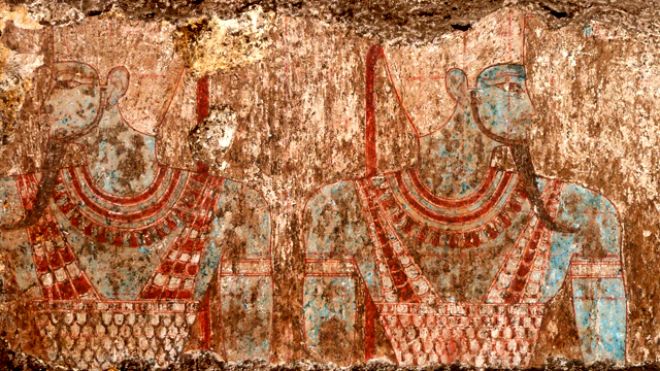
Painted, carved and inscribed thousands of years ago, hundreds of stone blocks that most likely formed a sacred temple were discovered in the ancient Egyptian capital once raided on the fictional explorer's quest for the ark, the country's archaeology society announced Monday.
The site, known as San El-Hagar or Tanis, is one of the most archaeologically rich areas of Egypt's Nile delta. It was famously portrayed as the resting place of the Ark of the Covenant, discovered by Indiana Jones in the film Raiders of the the Lost Ark.
An Ark has yet to be found, of course, but Dr. Zahi Hawass, Minister of State for Antiquities, was excited to announce the discovery of hundreds of ancient limestone blocks, which may have belonged to King Osorkon II.
French archaeologists found the colored and inscribed stones, which they believe were used to build the sacred lake walls of a temple dedicated to the goddess Mut. Dr. Philippe Brissaud, director of the French mission, confirmed that the sacred lake measures about 100 feet by 40 feet with a depth of 20 feet.
The team has so far cleaned about 120 blocks, 78 of which have inscriptions. Two blocks belong to King Osorkon III or IV, while the inscriptions mention the title "Mistress Mut of Isheru Lake," indicating both goddess and lake during the 21st and 22nd Dynasties, the state archaeology society said.
Dr. Mohamed Abd el Maksoud, head of office at the Ministry of State for Antiquities, said that this discovery adds great importance to the San El-Hagar site. The region is a huge priority for the agency, which has set aside 50 million Egyptian pounds ($8.4 million U.S.) to lower the water table, control agricultural drainage, and build an open-site museum complete with visitors center, tourist facilities and a museum magazine.
Ibrahaim Suleiman, general manager of Sharkia archaeological sites, said that San El-Hagar is one of the oldest Egyptian cities and contains many temples belonging to the god Amun. It was the capital of Egypt during the 21st and 22nd dynasties.
Excavation work began at this site in 1860 by Auguste Mariette, followed in 1884 by Flinders Petrie who discovered the Temple of Amun inside the old city. From 1928 to 1958 a French mission directed by Pierre Montet excavated the temples of Mut and Horus and the treasure of the royal necropolis, currently on display at the Egyptian Museum in Cairo.
Now under the direction of Brissaud, the inscriptions of this latest discovery are thought to be among the best quality reliefs found in Egypt.



Reader Comments
to our Newsletter